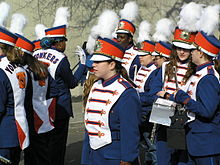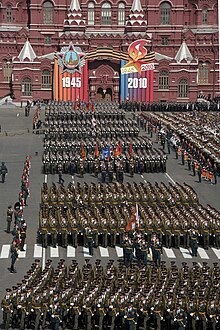Parade

A parade (also called march or marchpast) is a procession of people, usually organized along a street, often in costume, and often accompanied by marching bands, floats or sometimes large balloons. Parades are held for a wide range of reasons, but are usually celebrations of some kind. In Britain the term parade is usually reserved for either military parades or other occasions where participants march in formation; for celebratory occasions the word procession is more usual. In the Canadian Forces the term also has several less formal connotations.[1]
Protest demonstrations can also take the form of a parade, but such cases are usually referred to as a march instead.
Parade float
The parade float got its name because the first floats were decorated barges that were towed along canals with ropes held by parade marchers on the shore[citation needed]. Floats were occasionally propelled from within by concealed oarsmen, but the practice was abandoned because of the high incidence of drowning when the lightweight and unstable frames capsized. Strikingly, among the first uses of grounded floats — towed by horses — was a ceremony in memory of recently drowned parade oarsmen.[citation needed] Today, parade floats are traditionally pulled by motor vehicles or powered themselves.
Parade grand marshals
A grand marshal is an honorary title given to an individual by the organizing committee of a periodic parade event. Similar to guests of honor at fan conventions, a grand marshal is selected on any basis relevant to the theme or nature of the parade, and often leads the parade from the front. Multiple grand marshals may often be designated for an iteration of the parade, and may or may not be in actual attendance due to circumstances (including death).
Some parades, such as pride parades, may select a Community Grand Marshal or other designations alongside a Grand Marshal to lead the front or other parts of the parade.
Aircraft and boats
Since the advent of such technology, it became possible for aircraft and boats to parade. A flypast is an aerial parade of anything from one to dozens of aircraft, both in commercial context at airshows and also to mark, e.g., national days or significant anniversaries. They are particularly common in the United Kingdom, where they are often associated with Royal occasions. Similarly, for ships, there may be a sail-past of, e.g., tall ships (as was seen during Trafalgar 200) or other sailing vessels as during the celebrations of the 60th anniversary of World War II.
Longest parade
The longest parade in the world is the Hanover Schützenfest that takes place in Hanover every year during the Schützenfest. The parade is 12 kilometres long with more than 12,000 participants from all over the world, among them more than 100 bands and around 70 floats and carriages.
Types of parades
- Carnival parade
- Cavalcade
- Flypast
- Flower parade
- Military parade
- Parade of horribles
- Pride parade
- Santa Claus parade
- Technoparade
- Ticker-tape parade
- Victory parade
- Walking day
Examples of annual event parades



- Anheuser-Busch Washington's Birthday Parade, held annually in Laredo, Texas
- Attestation Parade New South Wales Police College graduation parade in Goulburn, New South Wales, Australia.
- Bastille Day Military Parade - Held annually in Paris, France in celebration of the Bastille Day
- Bud Billiken Parade and Picnic - Second largest annual parade in the United States, Held on the second Saturday in August in Chicago, Illinois.
- Calgary Stampede Parade
- Carnaval San Francisco
- Carnival in the Netherlands
- Chief of Defence Force Parade - Australian Defence Force Academy - Marks completion of Initial Military Training for Officer Cadets and Midshipman at ADFA
- Dahlia parade in Zundert always held on the first Sunday in September
- Days of '47 Parade in Salt Lake City
- Dragon of Shandon Samhain parade in Cork, held annually on the 31st of October at night
- Easter parade
- International Bank of Commerce "Under the Stars" youth parade, held annually in Laredo, Texas
- Macy's Thanksgiving Day Parade
- Mardi Gras
- Main Street Electrical Parade
- Marksmen's Parade, Hannover
- May Day Parade Russia
- McDonald's Thanksgiving Parade, Chicago IL
- Mummers Parade
- National Memorial Day Parade
- New York's Village Halloween Parade
- Notting Hill Carnival
- Orange Bowl Parade
- Orange walk
- Orlando Citrus Parade
- Philippine Independence Day Parade
- Procession of the Species
- Republic Day Parade in India
- Republic Day Parade in Pakistan
- Rose Parade in United States
- Saint Patrick's Day Parade Dublin, Munich, New York, Boston, and San Diego
- San Francisco Chinese New Year Festival and Parade
- Singapore National Day Parade
- Torchlight Parade, Seattle WA
- Toronto Santa Claus Parade
- Tournament of Roses Parade
- Trooping the Colour
- Victory Day parade, held annually in the Russian Federation and former USSR.
- Vikingland Band Festival Parade Marching Championship
- Walt Disney World Christmas Day Parade
- West Country Carnival
- Zinneke Parade
Historical parades
At the end of hostilities in Europe in 1944-45, "victory parades" were a common feature throughout the recently liberated territories. For example, on 3 September 1944, the personnel of the 2nd Canadian Infantry Division marched six abreast to the music of massed regimental pipe and drum bands through the streets of Dieppe, France to commemorate the liberation of the city from German occupation, as well as commemorate the loss of over 900 soldiers from that formation during the Dieppe Raid two years earlier.[2] On the Moscow Victory Parade of 1945 held in Moscow, Soviet Union in June 1945, the Red Army commemorated Victory in Europe with a parade and the ceremonial destruction of captured Wehrmacht and Waffen-SS standards.
Observances marked by parades


- Anzac Day - Australia and New Zealand
- Army Day
- Canada Day
- Caribana
- Carnival
- Chinese New Year
- Christmas
- Easter
- Independence Day
- Labor Day
- Mardi Gras
- Memorial Day
- Navy Day
- New Year's Day
- Pioneer Day (Utah) - Days of '47 Parade
- Samhain Ireland
- Schützenfest
- Solstice
- Thanksgiving
- St. Patrick's Day
- Puerto Rican Day Parade
- Victory Day
See also
Notes
- ^ An evening parade in the reserve force refers to any assembly of troops for a period of instruction, drill, or office work while a first parade refers to a preliminary inspection of a vehicle before a road march. A C.O.'s Parade is an inspection by the Commanding Officer. There are also Defaulters Parades and Kit Parades.
- ^ [1] Archived 2015-04-02 at the Wayback Machine
